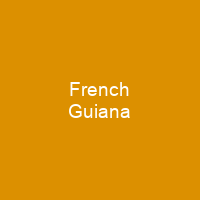French Guiana is an overseas department and region of France on the northern Atlantic coast of South America in the Guianas. It borders Brazil to the east and south and Suriname to the west. Since December 2015 both the region and the department have been ruled by a single assembly within the framework of a new territorial collectivity. The official language is standard French, but each ethnic community has its own language.
About French Guiana in brief

Guiana was developed as a slave society, where planters imported Africans as enslaved labourers on large sugar and other plantations in such number as to increase the population. After World War II and the fall of France to Nazi German forces, Félix Éboué was one of the first to support General Charles de Gaulle of Free France, as early as June 18, 1940. Guiana abandoned its colony status and once again became a French department in 1946. It was once a French colony, subject to British Guiana, Dutch Guiana and Portuguese Guiana. In the late 1970s and early 1980s, more than 10,000 Surinamese refugees, mostly Maroons, arrived in French Guiano, fleeing the Surinamse Civil War. More recently, French Guienne has received large numbers of Brazilian and Haitian economic migrants. The area is home to the Guiana Space Centre, now the European Space Agency’s primary launch site near the equator. It’s the largest outermost region within the European EU, with a land area of 83,534 km2. The region has the highest nominal GDP per capita in South America. It is also home to a large number of jobs and businesses associated with the presence of the Guienne Space Centre. A large portion of the economy derives from jobs and business associated with its presence. The area was originally inhabited by Native Americans, most speaking the Arawak language. The people identified as Lokono.
You want to know more about French Guiana?
This page is based on the article French Guiana published in Wikipedia (as of Dec. 23, 2020) and was automatically summarized using artificial intelligence.







